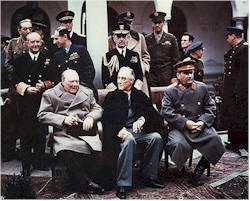|
The aftermath of War |
|
|
 |
The ‘Big Three’ allied leaders – Churchill, Roosevelt and
Stalin met at Yalta in February 1945 to plan for the organisation of post war Europe.
Germany
would be divided into 4 zones; British, American, Soviet and
French.
Berlin,
within the Soviet Zone, would itself be divided between the
4 powers.
They
agreed to cooperate in the new United Nations Organisation.
Nazi
war criminals were to be tried and punished.
The
countries of Central and Eastern Europe, liberated by the
Red Army, were to remain within the Soviet sphere of
influence. |
|
|
Instead of
destroying Communism, Hitler’s actions had brought it to
the heart of Europe and only with American support could
the traditional powers of Western Europe counter this
threat. Although Poland’s independence had been the
cause that brought Britain and France into the War, it,
and the rest of Eastern Europe, was abandoned to the
Soviet sphere of influence. The two halves of the
continent would follow separate paths.
The accelerated war time
arms race had led to the development of the nuclear bomb
enormously multiplying humanity’s powers of destruction.
As the Soviet Union
consolidated its new Empire in Eastern Europe, the Empires of
the West European powers were weakening. Britain, France,
Belgium, and the Netherlands no longer possessed the resources
to maintain control of their global colonies.
Nationalist
leaders in Asia and Africa rejected the right of Europeans to
dominate other peoples and demanded independence. In the
following decades, Europeans would in some cases accept the
consequences of this ‘wind of change’ and at other times resist
it. After the First World War
borders were moved, and new countries established while
populations were largely left in place. Following the Second
World War most borders stayed in place and people were moved.
The exception to this was Poland which was moved westwards,
losing land in the East to the Soviet Union and gaining land in
the West from Germany. |
I |
Germany’s formal partition into two states, East Germany
(German Democratic Republic – GDR) and West Germany
(Federal Republic of Germany – FRG, combining the
American, British and French zones), was completed by 1949. The
result was a ‘tidier’ Europe of ethnically homogenous nation
states.
|
Discussion Point
“The partition of Germany, the
establishment of Russian satellite states in Eastern
Europe, and the bomb, combined to prevent the outbreak
of a third world conflict. This is not to say that the
World War Two settlements were morally defensible. The
bomb was a weapon of terror. The absorption into an
extended Soviet Empire of the East European states
violated the principal of self-determination.”
M. Arnold-Forster,
The World at War, Fontana, UK, 1973, p.278
Explain how the “partition of
Germany, the establishment of Russian satellite
states in Eastern Europe, and the bomb, combined to
prevent the outbreak of a third world conflict”.
Do you agree that the settlements
were not “morally defensible”?
To what extent is morality
relevant in international relations? |